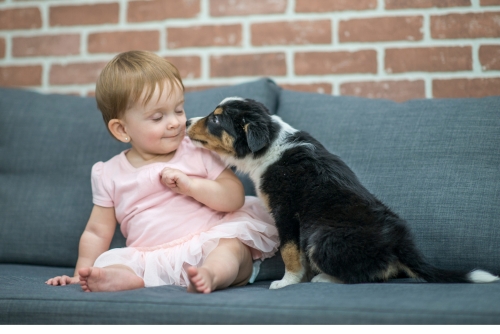If your pup is used to being the baby of the household, the introduction of a newborn can present challenges. Not only could your dog find the new sights, smells, and sounds (not to mention your shifting attention) unsettling, but her current behavior may not be baby-appropriate. Let’s look at some of the steps to prepare your puppy for new baby.
Make Gradual Changes to Your Home
Some dogs can become territorial about certain rooms, pieces of furniture, or humans—which can become apparent as you start to baby-proof your home and create spaces for the baby to sleep, eat, and play. Whenever possible, make these changes gradually so that your dog can adjust.
Phase out old furniture and bring in new furniture one piece at a time. Restrict your dog’s access to the nursery for longer periods each day until she understands that she can only go in with permission. Dogs crave consistency, and incremental changes are less disruptive and distressing.
Introduce Your Pup to New Smells and Sounds
It’s well known that dogs have a keener sense of smell than humans. You may not know that they also hear more frequencies and can hear sounds from farther away than we can, which means that some noises are exceptionally loud for your puppy’s sensitive ears.
Before the baby arrives, let her get familiar with the sensory experience of having a baby around. Work on decreasing her reaction to baby cries and squeals by playing recordings of those sounds (which you can find online) while she eats, sleeps, and does other activities that aren’t typically disrupted. Let her smell things like baby detergents and shampoo and reward her with treats and affection to create a positive association from the start.
Take Command
By far, the most important thing you need to do to prepare your puppy for a new baby is to focus on training. A trained dog knows that she needs to listen to commands the first time and look to you for direction when she’s not sure what to do next.
Working with a professional trainer will unlock a new level of communication between you and your pup. You’ll learn to recognize her body language and the signs that she’s becoming over-stimulated, over-excited, or confused. She’ll learn to recognize a long list of commands as well as the tones of your voice that indicate that she needs to calm down and regroup. When you’re in control, you create a safer environment for everyone, including your pup.
Focus on Child-Safe Behavior
There are certain behaviors that the adults in your household may tolerate that aren’t appropriate around babies and small children. This includes roughhousing, jumping, and barking to show excitement or to gain attention. During the course of your training, use positive reinforcement to phase out these behaviors and replace them with child-safe responses.
The trainers at ADU are here to help you and your puppy prepare for this next chapter. Learn more about our training programs today.



